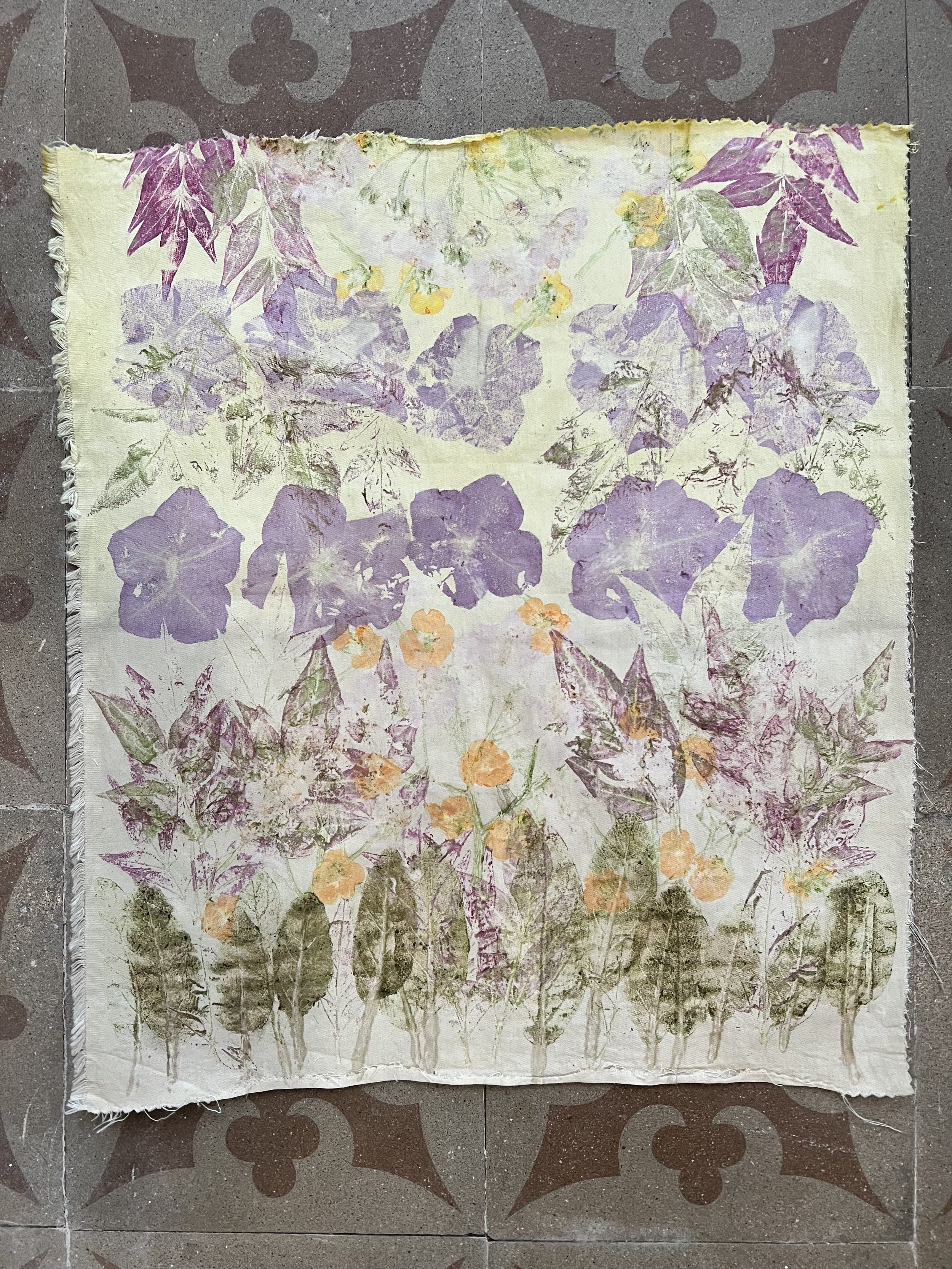Xeem Noor
Xeem Noor is a visual artist from Malaysia whose work explores the ideas of intersubjectivity, lifeworld, memories, personhood, and visual/sensorial expressions. In her work, she turns embroidery, textiles and vibrant colours into abstract forms, lines and geometry, combining the quickness of abstract painting and the slowness of hand embroidery.
Xeem undertook a residency at Cel del Nord in the summer of 2022. While she was here, she explored the local colour palette by using foraged colours to create works on fabric.
Xeem Noor in the studio, June 2022
Your residency was littered with the colours of nature, and a lot of the time those colours behaved unexpectedly. One of the first things that you said about this part of the world is that is was yellow. What made it yellow?
Coming from a tropical climate, I was used to (and perhaps took for granted) the bluish green or dark green foliage around me. The Catalan countryside, at first glimpse, had a lot of yellows, even in the bright greens and the soft pinks. The yellow, I gather, is from the wheat fields that we passed by and the stones used in the buildings. I was drawn to them from the moment I arrived.
There is no denying it, Oristà is a long way from Malaysia! How do you think the different atmosphere, colours and the sensation of distance came up in what you were working on?
During my first few days, I decided to keep a daily abstract watercolour journal to see what sorts of patterns, textures and colours I’d retained in my daily experience of Oristà. There are elements of nature in the soft yet vertical shapes and lines, in the rhythmic repetitions, and in the colours I chose. I can see quite a defined difference from the works I was recently making before the residency in terms of a more organic and natural approach to shapes and forms but I can also see “me” in the rhythm and repetition.
Xeem folds leaves and flowers into cotton that has been pre-died with carrot tops, then hammers the pigments from the flowers into the pattern that forms An Orchestra in The Garden (see right)
An Orchestra in the Garden, Xeem Noor 2022
And was that a conscious shift, or something that flowed naturally?
I think it’s a process that I developed through my training in architecture and arts. One way to design in architecture is to turn something figurative into abstract forms and shapes, like picking the essence of a concept and translating it into architectural shapes and forms. My process has always been trying to break down what I see into colours and patterns, it has become a habit after all these years.
And what is that you see in those works that is a reflection of yourself?
I have always incorporated repetition and rhythm, patterns and intricate details in my works, regardless of the colour palette or medium, and I tend to put meaning into every mark made. But, I’m also open to how others define the marks they see. That’s the beauty of abstract works, right? It’s not just a reflection of the artist but can be a reflection of the audience!
Diary day 3
Diary day 6
Diary day 8
Diary day 11
You made work using real flowers and leaves, and they rarely produced the colours that they promised in their untouched states. How did you deal with that?
It was fascinating. At first I was impatient, trying to find the colours I planned to use, like the green of the leaves or the reds of the flowers. That was especially frustrating with the time constraint. But this unpredictability of natural dyes taught me to not treat this method as a solitary process like painting or embroidery, but a collaborative one where the collaborator decides what shapes and colour palettes should appear on the textile. I was also reminded that using natural dye requires experimentation and I needed to approach dyeing in more scientifically. But scientific methods take time. I dealt with it by deciding to be more open to the results of the natural dyes and treat my works at the residency as an experiment of discovery that I hope to carry forward through my practice.
And when you mention a collaborator, do you mean the flowers and leaves that you were using? What does it mean to you to collaborate with nature?
Yes, I felt like my collaborator was Nature itself. It’s difficult to work with a collaborator that is set in their ways—Nature has her own laws for us to abide by—so it is a collaboration that happens after one party is done with their part and another takes over or adds her input. I think being aware of how much Nature’s law influenced working with dyes made me question how much artistic input is truly mine and how much is just borrowed, how much of “me” am I putting into each piece of dyeing work and how much is just letting Nature take her course. That’s why I decided that the dyed pieces are unfinished, that I need to do my part to turn it into an artwork before I can call it my own creation, whether that’s through manipulation in dyeing techniques, or designing the flower and leaf arrangements, or even deconstructing and reassembling the pieces.
And what are the next steps for those pieces?
Currently, I’m playing around with the pieces, combining different techniques of embroidery and fibre art. I don’t want to overwork the pieces–and they are already small pieces so I try not to use too many stitch techniques or colours in one.
How will you know when they are finished?
When it feels balanced and well-rounded, when it feels like there’s enough space for thought and contemplation but also enough detail and intricacy to keep the conversation going. I tend to see art-viewing as having a conversation between the artist and the viewer and when viewers interact with my textile works (touching and tracing the stitches), I feel like we’re having a special conversation. I love that so much! And I think having a series of small and different pieces will help achieve a robust conversation with the viewer and will also allow us to have a follow-up conversation in the future.










